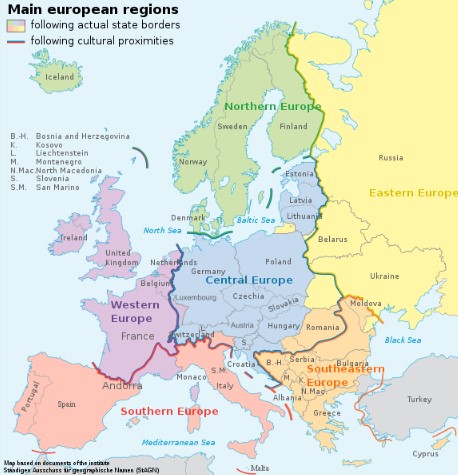Cost of IT Outsourcing: Benefits and Rates by Regions in 2024
- What Are IT Outsourcing Costs?
- Factors that Define IT Outsourcing Costs
- IT Outsourcing Cost Savings
- Which IT Services Can Be Outsourced?
- How Much Does IT Outsourcing Cost?
- Types of IT Outsourcing Models
- Factors Affecting Help Desk Costs
- IT Outsourcing: Best Practices
- How to Choose The Costs of Common IT Outsourcing Services
- Ways To Calculate Outsourcing Costs
- Outsourced Software Development Comparison by Regions
- IT Outsourcing Market Rates
- Staffing Capability
- Conclusion
Any business works on saving costs. Outsourcing services are considered an efficient option, especially in IT. This allows businesses to focus on their core business operations and strategies. They offer the managers specific qualifications or make the team’s workload more bearable. Let’s go into more detail on optimizing IT outsourcing costs and benefits this practice bears.
What Are IT Outsourcing Costs?
Outsourcing costs are direct and indirect expenses for delegated IT tasks to external parties.
Direct costs involve labor fees, vendor service charges, and infrastructure maintenance expenses. They include developers’ salaries, taxes, healthcare benefits, and bonuses. Count monthly fees for services like tech support or software development.
Indirect costs are the less apparent yet critical financial implications. They are related to transitioning operations, legal support for contractual agreements, remote monitoring and management tools.
It is crucial to consider potential hidden costs in an outsourcing contract to avoid unexpected expenses and budget overruns.

Factors that Define IT Outsourcing Costs
Factors that define IT outsourcing costs include pricing models and staffing capability.
- Pricing models such as fixed-cost, extended staff, and dedicated team offer varying levels of control.
- Staffing capability is the experience and location of the outsourced team. Junior coders are offered lower salaries but potentially require more guidance. Senior engineers get higher salaries for their expertise. Partnering with an IT service provider can enhance staffing capability by providing access to a skilled and experienced team.
- Geographical location influences prices due to differences in living costs.
IT Outsourcing Cost Savings
IT offers significant outsource value savings for businesses. Test offshore talent in countries with lower living fee to access skilled professionals. There’s a fraction of the cost compared to hiring locally. Hence, outsourcing allows flexible pricing. The businesses choose this approach to suit their budget and project requirements.
By outsourcing IT services, businesses can save money by cutting down costs, avoiding additional expenses, and finding more affordable subject matter experts.
Moreover, the practice reduces the need for investment in infrastructure. Training, employee benefits, and further low operational expenses are covered. IT subcontracting is an effective solution for businesses to streamline operations. Use it to enhance efficiency, and achieve strategic goals within budget.
Which IT Services Can Be Outsourced?
Lots of IT services can be outsourced, including:
- Software development: web app development, mobile app development, custom software development, and product engineering.
- Software development services: Outsourcing software development services can lead to significant cost savings by avoiding salaries, bonuses, benefits, and other hidden expenses. It also allows for the introduction of new technologies that can bring business value and cost savings ahead of competitors.
- IT support and helpdesk services. Delegate technical support, troubleshooting, and helpdesk services to handle customer inquiries, IT issues, and system maintenance.
- Infrastructure management: network management, server maintenance, cloud computing services, and IT infrastructure.
- Digital marketing services. Find specialists in digital marketing activities such as outsource web development and SEO. Content marketing, social media management, and email marketing enhance online visibility and reach target audiences.
- Quality assurance and testing. Give away software testing, QA processes, and test automation services.
- Data analytics: data mining, business intelligence reporting, and predictive analytics services.

In 2024, the benefits of IT outsourcing continue to be great for businesses worldwide.
- Cost savings. Outsourced IT gets skilled professionals and advanced technology at lower costs.
- Access to specialized expertise. Businesses open the global talent pool of specialized IT professionals. You can leverage the expertise needed to tackle complex projects effectively.
- Scalability and flexibility. The team scales their IT resources up or down based on changing demands and project requirements. You adapt to market dynamics without high overhead costs.
- Focus on core competencies. Work on driving innovation and growth and leave specialized tasks to experienced providers.
- Risk mitigation. You don’t have to worry about cybersecurity threats, regulatory compliance, and technology.
How Much Does IT Outsourcing Cost?
The cost of IT outsourcing varies a lot depending on several factors. Consider the following:
- type of services required
- project complexity
- provider location
- level of expertise.
An outsourcing company can assist with cost estimation and selecting the right provider, ensuring that businesses get the best value for their investment.
The hourly rates rely on the location of the provider and the level of expertise required. The rates may be higher in regions with a high cost of living, such as North America and Western Europe. Hourly rates may range from as low as $30-$40 in regions like South and Southeast Asia to over $100 in North America. At the same time, they may be lower in regions like Eastern Europe, Asia, and Latin America. Businesses should consider their specific requirements. Then, they analyze budgets to determine the cost of IT outsourcing. After that, it’s time to choose a pricing model and provider that aligns with the needs.
Types of IT Outsourcing Models
Generally, the cost of outsourcing in IT can be put into different pricing models:
- Fixed-price model. The provider charges a fixed amount for the project based on the agreed-upon scope of work. This model is suitable for well-defined projects with clear requirements.
- Time and materials model. The provider charges based on the time spent and the materials used for the project. The model offers more flexibility and is for projects with evolving requirements.
- Dedicated team model. The provider allocates a team of professionals to work only on the client’s project. The cost is based on the team’s size and the duration of the work process.
- Managed service provider (MSP) model. The business outsources IT services to a third-party expert. MSPs offer strategic technology expertise, specialized knowledge, advanced infrastructure, and round-the-clock support for tasks such as backup and recovery. Choosing a quality managed service provider is crucial for software development projects to implement Agile and DevOps practices and ensure that the software product fulfills the business goals.
Factors Affecting Help Desk Costs
Help desk costs are influenced by several factors. The top ones include app complexity and IT infrastructure. The level of support required (L1, L2, L3), the help desk team expertise, and languages play a significant role. Other factors include:
- the coverage hours needed (e.g., 24/7, 12/5)
- the volume of tasks handled per month
- the specific terms outlined in the service level agreement (SLA).
The average cost of IT support services varies based on these factors, as well as different business models for outsourcing IT.
The variety of communication channels also impact costs. They are voice and non-voice interactions, and the duration of calls.
IT Outsourcing: Best Practices
The best IT outsourcing practices have key points for partnerships and great outcomes.
- Set open and transparent communication channels between the client and the provider. Align expectations, address concerns fast, and foster collaboration.
- Define project objectives, scope, and timelines for both parties to share understanding of project requirements.
- Check potential partners based on their expertise, experience, track record, and cultural fit.
- Develop a solid contract that outlines roles and responsibilities, service level agreements (SLAs), and pricing structures. Discuss resolution mechanisms to mitigate risks and set accountability.
- Identify potential risks and develop risk management strategies to mitigate them. Make plans and regularly monitor project progress.
- Use performance monitoring mechanisms to track key metrics and analyze progress. Address any issues or deviations from agreed-upon standards right away.
- Work with a professional outsourcing provider to ensure consistency in innovation and staying up to date with the latest solutions and technologies. Develop a good working relationship and ensure transparent pricing to maintain predictable costs.
How to Choose The Costs of Common IT Outsourcing Services
When choosing the costs of common IT outsourcing services, follow several steps.
- Define your project requirements: the scope, timeline, and your budget.
- Conduct thorough research to identify potential partners.
- Look for relevant expertise and experience.
- Request detailed proposals from shortlisted providers, comparing their pricing models and offerings. It is important to compare different service providers’ pricing models and offerings to ensure you get the best value.
- Factor in the total cost of ownership with ongoing expenses such as maintenance and support.
- Negotiate pricing and terms but prioritize quality and value for money.
Follow these steps to select your organization’s most suitable IT outsourcing costs.
Ways To Calculate Outsourcing Costs
Calculating outsourcing involves a detailed examination of cost savings potential. It begins with a clear definition of business functions. Distinguish between tasks handled in-house versus those, for example:
- infrastructure maintenance
- employee salaries
- administrative services
- software development expenses.
When comparing costs, consider the expenses of maintaining an internal IT team versus outsourcing services.
Once in-house costs are determined, assess the total outsourcing value. Include expenses related to transitioning operations to an external provider, bid prices, and subscription fees. Remember any extra expenses for managing the outsource relationship. Count processing change orders or payments to contractors.
Cost Table Comparison
Identify both in-house and outsourcing expense to calculate potential delegating fee savings. Do it by subtracting the latter from the former. This comparison provides a clear understanding of the financial benefits of specific functions.
When comparing costs, consider the expenses associated with maintaining an in-house IT department versus outsourcing IT services.
In-House Cost Table
| Classification | In-House Costs |
| Software Development | $200,000 |
| Employees Salaries | $250,000 |
| Utilities | $25,000 |
| Rent | $137,000 |
| Total | $612,000 |
Outsource Cost Estimation Table
| Classification | Outsource Costs |
| Bidding Price | $150,000 |
| Contract Administration | $25,000 |
| Transitioning Operations | $10,000 |
| Application Development | $130,000 |
| Total | $315,000 |
Outsourced Software Development Comparison by Regions
The dynamics of each region’s IT specialists and rates are crucial in your outsourcing destination.
North America
Rates for IT outsourcing in North America are notably higher than anywhere else. The average is around $100 per hour. This high price stems from the region’s higher cost of living and wages compared to other parts of the world.

Latin America
IT specialists in Latin America, in countries like Costa Rica, offer competitive rates ranging from $45 to $75 per hour. The advantage is in their English level and U.S. time zones. Adhering to U.S. laws, Puerto Rico presents a favorable option for American companies.

Central and Eastern Europe
Central and Eastern European countries provide competitive rates. They are known for higher quality and good English level. With only a 1-3 hour time difference from Western Europe and a 7-12 hour difference from North America, communication is generally smooth. This region offers rates between $45 and $100 per hour.

South and Southeast Asia
Countries in this region offer the lowest rates, ranging from $30 to $40 per hour. Cost savings may come at the expense of quality here. The potential challenges are related to cultural differences and time zone disparities.
Outsourcing providers in South and Southeast Asia offer cost-effectiveness and access to a vast pool of talent, making them an attractive option for businesses looking to manage their budgets efficiently.
IT Outsourcing Market Rates
| Destination | Rates | Countries |
| North America | ~$100 | USA, Canada |
| Latin America | $45-75 | Argentina, Brazil, Mexico, Colombia, Peru, Chile |
| Central and Eastern Europe | $45-100 | Ukraine, Romania, Poland, Bulgaria, Hungary, Czech Republic, Slovakia, Belarus |
| South and Southeast Asia | $30-40 | India, China, Indonesia, Philippines, Vietnam, Pakistan, Malaysia, Bangladesh |
Staffing Capability
Staffing capability is a base for successful project execution. It counts various factors crucial for delivering high-quality solutions. First, the skill levels within the outsourcing team from junior to senior professionals matter. This determines the breadth of expertise available. Experience plays a vital role – relevant technologies and industries mean everything.
The team size influences capacity to handle projects of different levels. Specializations across software development, QA, and project management create versatility. Recruitment, ongoing training, language, and cultural alignment improve the team’s capabilities. Together, these factors ensure efficient and effective delivery that meets client requirements.
How to Choose an IT Outsourcing Destination
Consider multiple factors during the process:
- Cost-effectiveness. Compare labor costs like salaries and operational expenses, in potential destinations. Consider both hourly rates and general project costs.
- Talent quality. Assess the skill level and expertise of the workforce in each destination. Look for a strong talent pool with relevant experience in your industry and technology stack.
- Cultural compatibility. Check cultural factors such as language, work ethic, and communication style. Choose a destination where your team can collaborate and understand your business objectives.
- Time zone. Consider time zone differences and travel distance. Are real-time communication or onsite visits essential for your project?
- Political and economic factors. Check stability in the country to mitigate risks associated with geopolitics. Analyze regulatory changes or economic downturns.
- Infrastructure and technology. Assess the infrastructure: the internet, data security measures, and technological capabilities. A robust IT infrastructure plays an important role for the project execution.
Conclusion
Optimizing IT outsourcing costs takes a strategic approach. It considers factors such as direct and indirect expenses, pricing models, and staffing capabilities. By understanding the cost-saving potential and evaluating the total value, businesses can make decisions about delegating IT services. The benefits including fee savings, drive efficiency and innovation. They help organizations to focus on core competencies. Analyze the expense and different types of outsource models to make your choice.

Free website strategy session with a senior web expert
For over a decade, we’ve helped startups, SaaS companies, and service brands build high-performing websites that drive real results. Whether you’re planning a redesign, launching a new product, or need to scale your platform—our technical and UX expertise can help you move faster and smarter.
Ready to talk? Connect with a lead developer at Hutko.dev for a FREE 30-minute strategy call. Let’s map out your next step, together.
Book a Free Call





